Water flossers
In the news recently, reports question whether existing scientific research support oral health benefits associated with flossing. According to the American Dental Association (ADA), interdental cleaning is an essential part of oral health. Cleaning between the teeth can help remove plaque and food bacteria that can lead to gum disease or decay if not removed consistently and efficiently. More than 500 bacterial species can be found in plaque; some are good and some are bad for your mouth. Together with food debris, water and other components, the plaque buildup around the teeth and on the gum line will contribute to disease in teeth and gums. As doctors of oral health, dentists are in the best position to advise their patients on oral hygiene practices because they know their patient’s oral health status and health history.
There are several reasons patients do not floss. It can be a time issue, dexterity issue, or just a laziness issue. This is especially true with patients who are in braces. Even with the orthodontic flossers such as platypus and GUM brand, patients still find it difficult to floss. This also goes for patients with bridges and implants. The water flosser is a great option for all of these patients. It can be done right after brushing in the morning or at night.
The WaterPik water flosser is clinically proven to remove up to 99.9% of debris from treated areas. For patients with implants, it is up to twice as efficient as string floss in removing debris from implants. Patients with orthodontics, it is three times as efficient and up to 50% more effective for gum health than string floss. Our two favorite water flossers are made by WaterPik. The Advanced Performance Unit is cordless and can be used the shower and The Aquarius is our favorite counter unit.
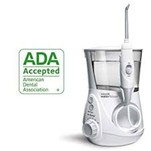
It comes with five different tips:
Classic Jet Tip – for general use, can be used for every patient.
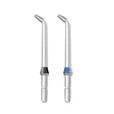
Orthodontic Tip – for patients with braces, specifically designed to reach underneath wires and around brackets to remove plaque.
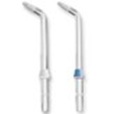
Plaque Seeker Tip – for patients with implants, crowns, bridges, permanent retainers, or general use. Removes bacteria and debris from hard to reach areas around dental restorations.
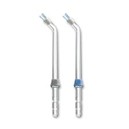
Pik Pocket Tip – periodontal pockets and furcations. Gently delivers medicaments and rinses deep below the gum line.
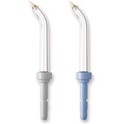
Toothbrush Tip – for general use. The convenience of brushing and water flossing at the same time.
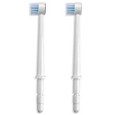
To use the water flosser, you fill the tank, it can be with warm water only, or warm water mixed with an anti-microbial rinse of your choice. NOTE: If you mix mouth rinse into the tank make sure you are flushing it out with water after – do this by putting water in the tank and just turning it on.) There are two “ON” buttons, one on the tank and one on the handle that goes in your mouth. Turn the tank on and then position the tip of your choice in the mouth in between two of the back teeth. Start on the lowest setting and then follow the margins of your teeth to the interdental space. Make sure you are over the sink in case any water spills out of your mouth. After a few teeth, you can turn off the handle and spit, then resume where you left off. Do this on the top and bottom arch once a day for optimal results. While flossing is still very important, the water flosser is a great alternative option.
